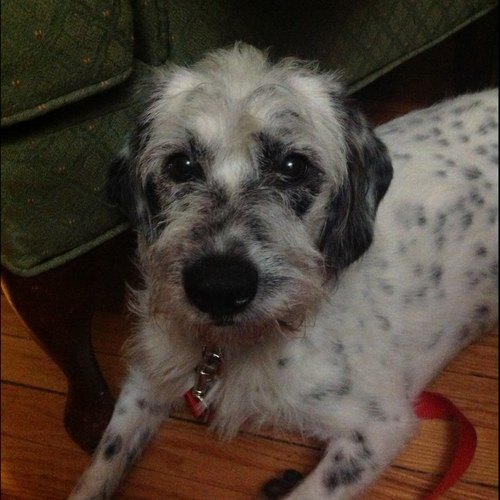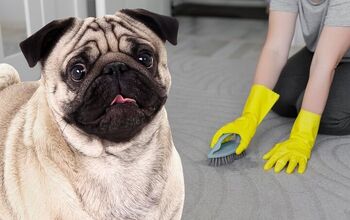Dalmadoodle


About Dalmadoodle
The unique Dalmadoodle also goes by a few other names: Dalmapoo, Dalmatiandoodle, and Dalmatianpoo.
Mixing the looks and personality traits of the Dalmatian and the Poodle, these intelligent, loyal, and loving dogs make wonderful companions. Before you bring home one of these cute pooches, though, you should learn about their needs so you’ll know what to expect.
Mixing the looks and personality traits of the Dalmatian and the Poodle, these intelligent, loyal, and loving dogs make wonderful companions.
The Dalmadoodle is a designer dog breed whose origins aren’t entirely clear.
The Dalmadoodle is a cross between a purebred Poodle and Dalmatian.
It’s always best to choose a high quality canine-appropriate food that will help your pet remain strong and healthy. If you have any questions about the ideal diet for your pet, whether that’s a commercial food, a homemade diet, or a raw diet, simply talk to your veterinarian.
Once you have found a dry dog food that contains natural ingredients, you can start by feeding your Dalmadoodle anywhere from 1½ to 3 cups of food every day, but split this amount into at least two meals. Your dog may need more or less food, depending upon his size, age, and activity level. Also, make sure your pet isn’t gaining too much weight, so establish a healthy balance between dry food, canned food, and treats.
You can expect that your Dalmadoodle will enjoy being around people and will love everyone.
If your Dalmadoodle has more of the Dalmatian personality, training him will be moderately easy and progress will be gradual, so patience is necessary. These dogs are smart, but they can also be independent and stubborn. Therefore, you will need to approach the training with consistency and firmness (without ever being harsh), and you need to keep it positive by reinforcing good behaviors with treats, rewards, and praise.
On the other hand, if your Dalmadoodle has inherited more of the Poodle’s personality, your pet will be easier to train. These intelligent dogs enjoy learning new things, and they can even be fun to train, so it’s a great way to bond with your pooch.
A medium to large-sized breed, the Dalmadoodle weighs between 40 and 70 pounds.
You can expect that your Dalmadoodle will enjoy being around people and will love everyone. Although Dalmadoodles can be protective and might be inclined to bark at strangers, they will become comfortable around new people once they get to know them.
These charming and friendly dogs could be easygoing and calm, but they can also be playful, brave, and goofy. They do require quite a bit of attention, so make sure you have the time to dedicate to your pet. In return, your Dalmadoodle will be loyal and loving.
As is the case with all hybrid canine breeds, the Dalmadoodle might be susceptible to developing the health conditions that affect its parent breeds. However, hybrid dogs can be surprisingly hardy and healthy, and there’s no way to predict an individual pet’s long-term health.
The Dalmadoodle might be prone to urinary stones, hip dysplasia, skin allergies, iris sphincter dysplasia, Cushing’s disease, Addison’s disease, sebaceous adenitis, gastric dilatation-volvulus, and deafness.
The Dalmadoodle has an average lifespan of 11 to 14 years.
If your Dalmadoodle has inherited more of the Poodle’s traits, he will need to get a moderate amount of physical activity daily in order to remain easygoing and calm. Just be sure to provide your pet with a daily walk, trips to the dog park, and time off-leash in the backyard if you have one that is safe and enclosed. You should also keep this smart dog’s mind stimulated with the help of a variety of toys, especially while spending time indoors. And because these dogs love learning, you can teach your pet new tricks and go beyond basic obedience training as well.
On the other hand, if your Dalmadoodle is more like the Dalmatian, he will be highly active, so you will need to be active as well. A backyard with room to run around freely is preferred, and you will need to take your pet out for a long, brisk walk a couple of times each day. You can also take your dog jogging or hiking, as well as to the dog park, and you can play games and provide him with toys to burn off energy. Ultimately, the goal will be to keep your high-energy pooch stimulated both physically and mentally, as that will prevent destructive and negative behaviors.
Dalmadoodles can be easygoing and calm, but they can also be playful, brave, and goofy.
The Dalmadoodle is not recognized by the American Kennel Club, as it is considered to be a hybrid breed. However, this breed is recognized by the American Canine Hybrid Club (ACHC) and the Dog Registry of America, Inc. (DRA).
A Dalmadoodle’s coat could be dense and curly like the Poodle, or short, fine, and dense like the Dalmatian. Either way, you will need to brush the dog’s coat daily in order to keep it healthy, clean, and free of tangles.
If your dog’s coat is more like the Poodle’s, it won’t shed a lot, but trips to the grooming salon on a regular basis will be necessary for stripping and trimming. This isn’t necessary if the coat is like that of the Dalmatian, but, in that case, the coat will shed a lot.
As with all puppies, you will need to be gentle when handling a tiny Dalmadoodle. If children will be playing with your puppy, be there to supervise to make sure no one gets hurt.
Dalmadoodles should be trained and socialized from a young age so they’ll grow up to be confident adults who will get along well with everyone they meet. If you want your dog to be happy around children and other pets, socialization will be the key.
Photo credit: Marcelo Brito/Flickr

Lisa Selvaggio is a freelance writer and editor, and our resident cats-pert, with certifications in pet nutrition and pet first aid. She enjoys producing content that helps people understand animals better so they can give their pets a safe and happy home.
More by Lisa Selvaggio

























